- Home
- »
- Medical Devices
- »
-
Negative Pressure Wound Therapy Market Size Report, 2030GVR Report cover
![Negative Pressure Wound Therapy Market Size, Share & Trends Report]()
Negative Pressure Wound Therapy Market Size, Share & Trends Analysis Report By Product (Conventional NPWT Devices, Single-Use NPWT Devices, NPWT Accessories), By Wound Type (Chronic Wounds, Acute Wounds), By End-use, By Region, And Segment Forecasts, 2024 - 2030
- Report ID: GVR-1-68038-208-2
- Number of Report Pages: 150
- Format: PDF, Horizon Databook
- Historical Range: 2018 - 2022
- Forecast Period: 2024 - 2030
- Industry: Healthcare
Market Size & Trends
The global negative pressure wound therapy market size was estimated at USD 2.49 billion in 2023 and is projected to grow at a compound annual growth rate (CAGR) of 6.64% from 2024 to 2030. Increasing demand for advanced wound care is expected to propel negative pressure wound therapy (npwt) devices market. Single-use NPWT devices are gaining traction in the field of wound care management over conventional products. For instance, in January 2022, Smith+Nephew announced that the FDA cleared its Single Use Negative Pressure Wound Therapy (sNPWT) Systems PICO 7 and PICO 14 for new indications in closed surgical incisions, which can help lower the occurrence of dehiscence, postoperative seroma, and superficial and deep incisional Surgical Site Infections (SSIs).
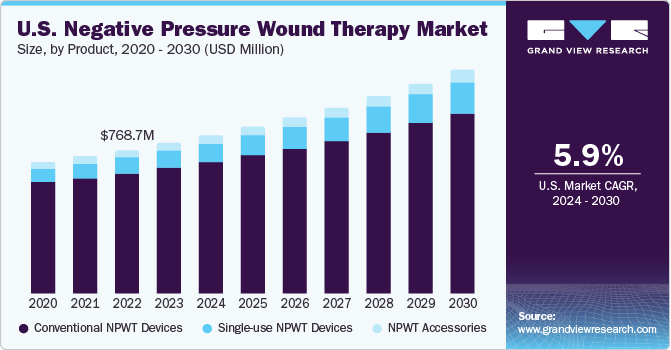
The increasing prevalence of chronic diseases, such as diabetes, cancer, and autoimmune conditions, is further anticipated to propel the market over the forecast period. This is primarily attributable to the fact that diabetes often results in complications such as diabetic foot ulcers. As per a report by WHO, in March 2023, about 422 million live with diabetes globally in 2023, Diabetes can contribute to an increased occurrence and complexity of various wounds, including infections, ulcerations (such as leg or foot ulcers), and acute wounds like surgical and traumatic wounds.
In addition, the increasing prevalence of obesity is another key factor likely to drive market growth, as it is associated with lower extremity amputations and chronic wounds. According to the World Obesity Federation, estimated that around 1 billion people globally, including 1 in 7 men and 1 in 5 women, will be living with obesity by 2030. Obese people are at a higher risk of pressure ulcers, with lowered vascular action in adipose tissue. Thus, this factor will likely boost the demand for these products, leading to market growth.
Elderly people have low immunity levels and thus, are prone to chronic disorders, such as diabetes, cancers, and heart diseases. Rising geriatric population is a significant factor propelling the growth of the negative pressure wound therapy devices market. According to the WHO data published in October 2022, by 2030, one out of every six people worldwide will be 60 years or older. During this period, the number of individuals in this age group will rise from 1 billion in 2020 to 1.4 billion. By 2050, the global population of those aged 60 and above is anticipated to double, reaching 2.1 billion. Moreover, the number of people aged 80 years or older is projected to triple by 2050, reaching a total of 426 million, compared to the figures recorded in 2020. These abovementioned factors are expected to drive the demand for negative pressure wound therapy devices over the forecast period.
Market Concentration & Characteristics
The market growth stage is moderate, and the pace of the market growth is accelerating. The negative pressure wound therapy market is characterized by a moderate-to-high degree of growth. Key drivers include the global aging population, prevalence of chronic diseases, and advancements in NPWT devices. Regulatory compliance, reimbursement policies, and trend towards home healthcare also shape the market dynamics.
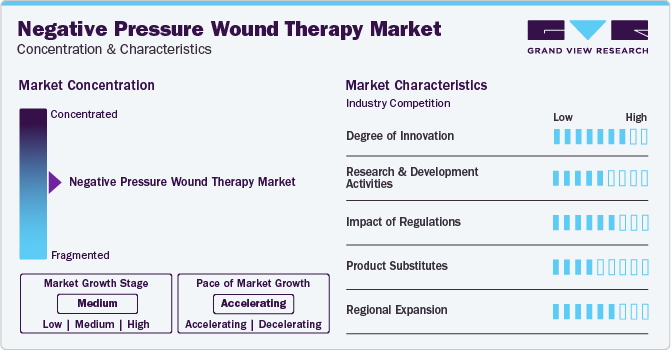
Key strategies implemented by players in negative pressure wound therapy market are new product launches, expansion, acquisitions, partnerships, and other strategies. In April 2023, Convatec Group PLC acquired 30 Technology Limited’s anti-infective nitric oxide technology platform, which includes new product assets and R&D. In addition to enhanced wound care, Convatec plans to explore the technical platform for use in other businesses.
The market is witnessing a substantial degree of innovation driven by rapid technological advancements and the increasing adoption of advanced products, particularly in home care settings. Companies investing significantly in these advanced technologies are gaining a competitive edge, contributing to the overall market growth. Thesingle-use systems, wireless remote monitoring, and enhanced patient mobility, the latest NPWT devices are designed to provide more effective and efficient wound healing solutions. Such advancements and innovations in negative pressure wound therapy drive market growth.
The market is significantly influenced by stringent quality protocols and regulatory norms enforced by various nations, aimed at ensuring patient safety and data integrity. Market participants with robust compliance measures and a proven track record of meeting regulatory standards not only enhance patient trust but also gain preference from MedTech sponsors.
Companies are actively acquiring development-stage firms to broaden their product portfolios, catering to a larger patient base. These collaborative efforts aim to strengthen relationships and improve the implementation of clinical programs pitched towards reducing hospitalizations for members. For instance, in March 2022, Convatec Group PLC completed the acquisition of Triad Life Sciences, Inc. to enter the wound biologics segment. Triad’s team, current portfolio, and product pipeline were transitioned to Convatec’s Advanced Wound Care (AWC) business, known as Convatec Advanced Tissue Technologies.
The market comprises a large number of medical device manufacturers leads to a highly fragmented market scenario.
Negative pressure wound therapy companies are increasingly prioritizing regional expansion to gain a competitive edge and expand their market reach. This involves forming partnerships, making acquisitions, and adopting localized marketing strategies to establish a stronger presence in key geographical areas. By customizing their products and services to cater to the unique healthcare requirements of different regions, these companies aim to improve accessibility and responsiveness, which in turn can lead to better market penetration. Overall, regional expansion is a crucial element for industry leaders to explore new markets, address specific healthcare demands, and drive sustained growth.
Product Insights
On the basis of product, the market has been segmented into conventional NPWT devices, single-use NPWT devices, and NPWT accessories. The conventional segment accounted for the largest market share of 84.21% in 2023. This can be attributed to their high price and increasing adoption globally. Conventional NPWT devices reduce the length of hospital stay for patients, reducing the total cost of treatment and favoring the adoption of this device over single use. Furthermore, it can be rented and purchased, which is expected to increase the usage rate of conventional NPWT in developing countries owing to its low purchasing power, thereby driving segment growth.
The Single-use NPWT devices segment is expected to witness the fastest growth over the forecast period. This is due to its wide applicability in home care settings, prompting major companies to focus on increasing their cost-effectiveness. According to the National Center for Biotechnology Information (NCBI), the estimated cost of sNPWT per patient was 19,986 compared to USD 20,572 for surgical complications (SC). This cost-effectiveness has proved an added advantage for single-use NPWT devices in developing countries, these factors are driving segment growth.
Wound Type Insights
The chronic wounds segment dominated the market in 2023. This can be attributed to an increasing number of geriatric populations and an increase in the prevalence of chronic wounds, such as diabetic foot ulcers and venous pressure ulcers, are expected to drive segment growth. As per data published by Wound Care Advantage, in May 2023, about 8.2 million people over the age of 65 and above have chronic wounds in America. Thus, increasing geriatric population with chronic wounds is anticipated to drive segment growth during the forecast period.
The acute wounds segment is expected to witness the fastest growth over the forecast period. The rising incidences of burns injuries across the globe and rising number of SSIs is one of the major driving factors for the segment growth. For instance, according to data published by Rosenfeld Injury Lawyers, in March 2023, about 450,000 people suffer from burn injuries each year in America. These factors are propelling the segment growth.
End-use Insights
Hospitals segment dominated the market in 2023 on account of a high volume of patients due to the increasing chronic diseases globally. In addition, NPWT devices are widely used in hospital settings, which include acute care centers and community hospitals. Moreover, the rising number of hospitals is anticipated the segment growth. According to the American Hospital Association, in 2023, around 6,129 hospitals were available in the U.S. Thus, introducing new healthcare hospitals and new patients for wound treatment spurs the demand for negative pressure wound therapy devices in the forecast period.
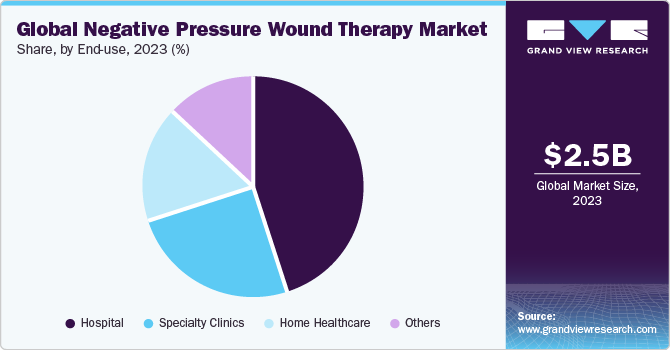
The home healthcare segment is expected to witness the fastest growth over the forecast period. NPWT therapy designed for home use is emerging, owing to the introduction of technologically advanced single-use and traditional NPWT systems. These innovations eliminate the necessity for hospitalization, making the overall therapy cost-efficient when applied in a home setting.
Regional Insights
North America accounted for the highest market share in 2023. This can be attributed to the rising number of road accidents, sports injuries, and the presence of several key players in the region is anticipated to drive the market in North America. The region is continuously developing cost-efficient and advanced devices for the patients to capture a huge share of the market. In addition, the rise in the number of hospitals and the growing geriatric population are factors responsible for the regional market growth.
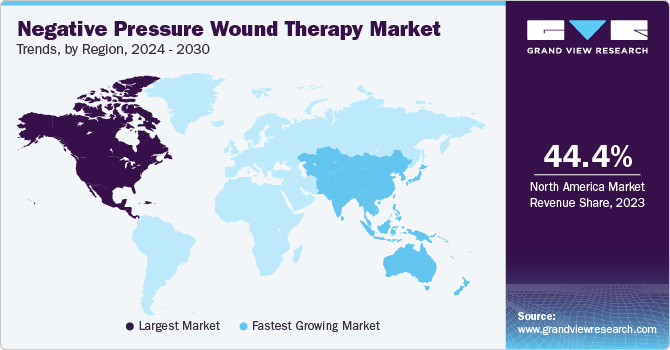
U.S. accounts for the largest market share in North America market. This can be attributed to the high incidence rate of chronic wounds in the U.S. and the rising geriatric population in U.S. is expected to boost the market growth. For instance, in May 2023, the CDC estimates that 6 in 10 adults in the U.S. currently live with a chronic disease such as cancer, heart disease, or diabetes.
Asia Pacific is expected to be the fastest-growing region during the forecast period because of the rising target population base with increasing chronic diseases, the need for medical equipment by the patients, and supportive government initiatives. In addition, the rapidly growing medical tourism industry in these countries can also be attributed to the increase in demand for NPWT in this region coupled with improvements in healthcare infrastructure will contribute to the region’s growth.
China accounts for the largest market share in Asia Pacific market. As per the National Library of Medicine report, the proportion of elderly people in China's population is increasing, indicating a demographic shift towards an aging society. As a result, the incidences of diabetes and diabetic foot have been increasing. These factors are expected to drive the segment’s growth over the forecast period.
Key Negative Pressure Wound Therapy Company Insights
Market trends are shaping negative pressure wound therapy company’s strategies. Heavy investments in research and development for technological innovations reflect a commitment to connected healthcare solutions. Top negative pressure wound therapy brands are adapting to the shift towards home healthcare through strategic partnerships and acquisitions, expanding their offerings for patients seeking accessible solutions.
Key Negative Pressure Wound Therapy Companies:
The following are the leading companies in the negative pressure wound therapy market. These companies collectively hold the largest market share and dictate industry trends. Financials, strategy maps & products of these NPWT companies are analyzed to map the supply network.
- 3M
- Talley Group Ltd (Direct Healthcare Group)
- Smith+Nephew
- Mölnlycke Health Care
- Medela AG
- DeRoyal Industries, Inc.
- Convatec Inc.
- Cardinal Health
- Paul Hartmann AG
Recent Developments
-
In May 2023, Smith+Nephew received an innovative technology contract for its PICO Single Use Negative Pressure Wound Therapy Systems from Vizient, Inc. This contract will strengthen research and development related to NPWT, thereby driving market growth.
-
In April 2023, Convatec Group PLC acquired 30 Technology Limited’s anti-infective nitric oxide technology platform, which includes new product assets and R&D. In addition to enhanced wound care, Convatec plans to explore the technical platform for use in other businesses.
-
In August 2023, Medela launched novel Invia Integrated Dressing for different types of wounds.
-
In January 2022, Smith+Nephew announced that the FDA cleared its Single Use Negative Pressure Wound Therapy (sNPWT) Systems PICO 7 and PICO 14 for new indications in closed surgical incisions, which can help lower the occurrence of dehiscence, postoperative seroma, and superficial and deep incisional Surgical Site Infections (SSIs)
Negative Pressure Wound Therapy Market Report Scope
Report Attribute
Details
Market size value in 2024
USD 2.63 billion
Revenue forecast in 2030
USD 3.87 billion
Growth rate
CAGR of 6.64% from 2024 to 2030
Actual data
2018 - 2023
Forecast period
2024 - 2030
Report updated
January 2024
Quantitative units
Revenue in USD million/billion and CAGR from 2024 to 2030
Report coverage
Revenue forecast, company ranking, competitive landscape, growth factors, and trends, product outlook
Segments covered
Product, wound type, end-use, region
Regional scope
North America; Europe; Asia Pacific; Latin America; MEA
Country Scope
U.S.; Canada; UK; Germany; Italy; France; Spain; Denmark; Sweden; Norway; Japan; China; India; South Korea; Australia; Thailand; Brazil; Mexico; Argentina; South Africa; Saudi Arabia; UAE; Kuwait
Key companies profiled
3M; Talley Group Ltd (Direct Healthcare Group); Smith+Nephew; Mölnlycke Health Care
Medela AG; DeRoyal Industries, Inc.; Convatec Inc.
Cardinal Health; Paul Hartmann AG
Customization scope
Free report customization (equivalent up to 8 analysts working days) with purchase. Addition or alteration to country, & segment scope.
Pricing and purchase options
Avail customized purchase options to meet your exact research needs. Explore purchase options
Global Negative Pressure Wound Therapy Market Report Segmentation
This report forecasts revenue growth at regional and country levels and provides an analysis of the latest industry trends in each of the sub-segments from 2018 to 2030. For this study, Grand View Research has segmented the global negative pressure wound therapy market report based on product, application, end-use, and region:
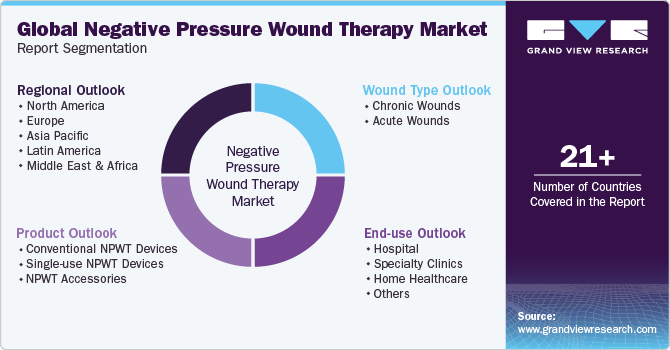
-
Product Outlook (Revenue, USD Million, 2018 - 2030)
-
Conventional NPWT Devices
-
Single-use NPWT Devices
-
NPWT Accessories
-
-
Wound Type Outlook (Revenue, USD Million, 2018 - 2030)
-
Chronic Wounds
-
Pressure Ulcer
-
Diabetic Foot Ulcer
-
Venous Leg Ulcer
-
Others
-
-
Acute Wounds
-
Surgical & Traumatic Wounds
-
Burns
-
-
-
End-use Outlook (Revenue, USD Million, 2018 - 2030)
-
Hospital
-
Specialty Clinics
-
Home Healthcare
-
Others
-
-
Regional Outlook (Revenue, USD Million, 2018 - 2030)
-
North America
-
U.S.
-
Canada
-
-
Europe
-
UK
-
Germany
-
Italy
-
France
-
Spain
-
Denmark
-
Sweden
-
Norway
-
-
Asia Pacific
-
Japan
-
China
-
India
-
South Korea
-
Australia
-
Thailand
-
-
Latin America
-
Brazil
-
Mexico
-
Argentina
-
-
Middle East & Africa
-
UAE
-
Saudi Arabia
-
South Africa
-
Kuwait
-
-
Frequently Asked Questions About This Report
b. Some key players operating in the negative pressure wound therapy market include 3M Company, Talley Group Ltd, Smith & Nephew, Devon Medical Products, Molnlycke Health Care AB, Medela AG, DeRoyal Industries Inc., Covatec Inc. Cardinal Health, Paul Hartmann AG and Others
b. Key factors that are driving the negative pressure wound therapy market growth include increasing demand for advanced wound care, rising prevalence of chronic and acute wounds, rising number of surgeries, and technological advancements.
b. The global negative pressure wound therapy market size was estimated at USD 2.49 billion in 2023 and is expected to reach USD 2.63 billion in 2024.
b. The global negative pressure wound therapy market is expected to grow at a compound annual growth rate of 6.64% from 2024 to 2030 to reach USD 3.87 billion by 2030
b. North America dominated the hydrocolloid dressings market in 2022 during the forecast period and is expected to witness a growth rate of 6.16% over the forecast period. This can be attributed to the presence of key players, the presence of well-developed healthcare infrastructure, and rising demand for advanced treatment options, owing to the increasing prevalence of wounds, and growing efforts by the government to reduce the overall treatment duration.
Share this report with your colleague or friend.
![gvr icn]()
NEED A CUSTOM REPORT?
We can customize every report - free of charge - including purchasing stand-alone sections or country-level reports, as well as offer affordable discounts for start-ups & universities. Contact us now
![Certified Icon]()
We are GDPR and CCPA compliant! Your transaction & personal information is safe and secure. For more details, please read our privacy policy.
We are committed towards customer satisfaction, and quality service.
"The quality of research they have done for us has been excellent."





